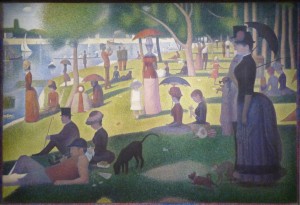IMPRESSIONISM

Seurat, A Sunday on La Grande Jatte—-1884
by Steven Zucker, used under CC0
Impressionism is a form of art in which the author captures the image of an object as another person would see it. Pictures are typically painted with vivid colors and mainly outdoor scenes. Artists of the Impressionism style focuses more on color rather than detail. The most famous artists of Impressionism are: Edouard Manet, Camille Pissaro, Edgar Degas, Alfred Sisley, Claude Monet, Berthe Morisot and Pierre Auguste Renoir. These artists all departed from the traditional painting styles of illusion of subjects and painted more life like pieces of art (Impressionism 2014).
The 19th century brought a time of change to Paris. While the Emperor Napoleon III was rebuilding Paris, the Academie des Beaux-Arts dominated French art. Academie des Beaux-Arts, Academy of Fine Arts, is a French learned society. In this academy, they preserved the traditional French painting standards of content and style. The academy preferred artwork that looked realistic up close and was painted in somber colors that hid the artists true personality (Impressionism 2014).
The academy had a jury that chose which artists’ work would be displayed in the annual art show called the Salon de Paris. In 1863, the jury rejected a painting that was submitted by Édouard Manet because it displayed a naked woman in a contemporary setting. This rejection was found appalling by many other French artists. Even the Emperor saw the rejected work and formed a new salon called, Salon des Refusés, that allowed the public to be the judge of the artwork (Impressionism 2014).

Dejeuner sur l’herbe’ by Manet
by Martin Beek, used under CC0
Claude Monet, Pierre-Auguste Renoir, Alfred Sisley, and Frédéric Bazille all enjoyed painting together and after the Salon des Refusés was formed the four men organized the Cooperative and Anonymous Association of Painters, Sculptors, and Engravers to show off their work independently. By the time the association had their first exhibition there were 30 artists that entered their work. This is the start of what we know today as Impressionism. Claude Monet titled one of his pieces, Impression, Sunrise that he entered into the art show. A writer for a newspaper called the exhibition, The Exhibition of the Impressionists, the name by which these artists later becomes known as. Impressionists quickly became accepted with the public and the artists themselves. The artists were all very different and unique in their painting styles but were brought together by their independence and their rebellion from the French Art norms. The exhibition happened eight different times in 12 years (Impressionism 2014).
Claude Monet, Alfred Sisley, Berthe Morisot, and Camille Pissarro were considered the “purest” Impressionists because of their consistent work of art that captured the sunlight and color. Although these artists didn’t make high earnings from their art, they won over the public’s support. By the late 1800s the method of Impressionist painting had become a common style in Salon art and led way for the Post Impressionist artists such as Vincent Van Gogh and Georges Seurat (Impressionism 2014).
For more information on the different artists that helped shaped the Impressionist Art Form click HERE.
Beek, M. (Year of Creation). Dejeuner sur l’herbe’. [Digital Image]. https://www.flickr.com/photos/oxfordshire_church_photos. Public Domain Image.
Impressionism. (2014). In Encyclopaedia Britannica. Retrieved from http://www.britannica.com/EBchecked/topic/284143/Impressionism
rm996s. (2009). Just a Painter. [Digital Image]. https://www.flickr.com/photos/rm996s. Public Domain Image.
Zucker, S. (2012). Seurat, A Sunday on La Grande Jatte. [Digital Image]. https://www.flickr.com/photos/profzucker. Public Domain Image.

